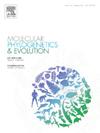枇杷科枇杷属和枇杷族的系统发育学和生物地理学新见解。
IF 3.6
1区 生物学
Q2 BIOCHEMISTRY & MOLECULAR BIOLOGY
引用次数: 0
摘要
目前,水仙属是水仙科中最大的属。先前对Palaquium及其部落Isonandreae之间关系的研究基于有限的采样和位点,这未能解决分类界限,阻碍了对这个马来中心属的进化的理解。本研究使用高通量、目标捕获DNA序列数据,在迄今为止最全面的近物种水平采样中恢复系统发育关系(120个已识别的Palaquium物种中的~ 80% %以及Isonandreae部落中所有7个属的代表)。分析证实,Palaquium不是单系的,因为目前的限制。在亚洲有一个与Isonandra属关系更密切的分支,而Aulandra属嵌套在Palaquium中。增强的系统发育数据集提供了重建生物地理历史的机会,同时应用了传统的分散-灭绝-枝生模型和一个新的模型框架,该模型框架考虑了未记录的灭绝。这一结果支持了之前关于马来群岛从西向东殖民的发现,类似于其他几个植物群。然而,恢复的Palaquium和Isonandreae部落的多样化时间比以前的研究要早,这表明Sundaland的北方热带替代特征和祖先范围的可能性更接近始新世的化石记录。这些发现增强了我们对东南亚生物多样性丰富和地质动态区域生物地理格局的认识。本文章由计算机程序翻译,如有差异,请以英文原文为准。

Novel phylogenomic and biogeographic insights into Palaquium and tribe Isonandreae (Sapotaceae)
Palaquium is currently the largest genus in the sapodilla family Sapotaceae. Previous studies of relationships within Palaquium and its tribe Isonandreae have been based on limited sampling and loci, which have failed to resolve taxonomic boundaries and hindered the understanding of evolution in this Malesian-centric genus. This study uses high-throughput, target capture DNA sequence data to recover phylogenetic relationships in the most comprehensive near species-level sampling to date (∼80 % of 120 recognised Palaquium species as well as representatives of all seven genera in tribe Isonandreae). The analyses confirm that Palaquium is not monophyletic as currently circumscribed. There is a divergent Asian clade more closely related to the genus Isonandra, and the genus Aulandra is nested within Palaquium. The enhanced phylogenetic dataset provided the opportunity to reconstruct biogeographic history, applying both traditional dispersal-extinction-cladogenesis models and a newer modelling framework that accounts for unrecorded extinctions. The results support previous findings of west to east colonisation in the Malesian archipelago, similar to several other plant groups. Recovered diversification timings of Palaquium and tribe Isonandreae are however older than in previous studies, pointing to a boreotropical vicariant signature and ancestral range possibilities within Sundaland that reconcile more closely to Eocene fossil records. These findings enhance our understanding of biogeographic patterns in the biodiversity-rich and geologically dynamic region of Southeast Asia.
求助全文
通过发布文献求助,成功后即可免费获取论文全文。
去求助
来源期刊
CiteScore
7.50
自引率
7.30%
发文量
249
审稿时长
7.5 months
期刊介绍:
Molecular Phylogenetics and Evolution is dedicated to bringing Darwin''s dream within grasp - to "have fairly true genealogical trees of each great kingdom of Nature." The journal provides a forum for molecular studies that advance our understanding of phylogeny and evolution, further the development of phylogenetically more accurate taxonomic classifications, and ultimately bring a unified classification for all the ramifying lines of life. Phylogeographic studies will be considered for publication if they offer EXCEPTIONAL theoretical or empirical advances.

 求助内容:
求助内容: 应助结果提醒方式:
应助结果提醒方式:


